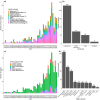A systematic review of approaches to assess fish health responses to anthropogenic threats in freshwater ecosystems
- PMID: 38706739
- PMCID: PMC11069195
- DOI: 10.1093/conphys/coae022
A systematic review of approaches to assess fish health responses to anthropogenic threats in freshwater ecosystems
Abstract
Anthropogenic threats such as water infrastructure, land-use changes, overexploitation of fishes and other biological resources, invasive species and climate change present formidable challenges to freshwater biodiversity. Historically, management of fish and fishery species has largely been based on studies of population- and community-level dynamics; however, the emerging field of conservation physiology promotes the assessment of individual fish health as a key management tool. Fish health is highly sensitive to environmental disturbances and is also a fundamental driver of fitness, with implications for population dynamics such as recruitment and resilience. However, the mechanistic links between particular anthropogenic disturbances and changes in fish health, or impact pathways, are diverse and complex. The diversity of ways in which fish health can be measured also presents a challenge for researchers deciding on methods to employ in studies seeking to understand the impact of these threats. In this review, we aim to provide an understanding of the pathway through which anthropogenic threats in freshwater ecosystems impact fish health and the ways in which fish health components impacted by anthropogenic threats can be assessed. We employ a quantitative systematic approach to a corpus of papers related to fish health in freshwater and utilize a framework that summarizes the impact pathway of anthropogenic threats through environmental alterations and impact mechanisms that cause a response in fish health. We found that land-use changes were the most prolific anthropogenic threat, with a range of different health metrics being suitable for assessing the impact of this threat. Almost all anthropogenic threats impacted fish health through two or more impact pathways. A robust understanding of the impact pathways of anthropogenic threats and the fish health metrics that are sensitive to these threats is crucial for fisheries managers seeking to undertake targeted management of freshwater ecosystems.
Keywords: Anthropogenic threats; conservation physiology; health indicators.
© The Author(s) 2024. Published by Oxford University Press and the Society for Experimental Biology.
Conflict of interest statement
The authors have no conflicts of interest to declare.
Figures






Similar articles
-
Disentangling the effects of different human disturbances on multifaceted biodiversity indices in freshwater fish.Ecol Appl. 2023 Jun;33(4):e2845. doi: 10.1002/eap.2845. Epub 2023 Apr 4. Ecol Appl. 2023. PMID: 36922403
-
Major threats to European freshwater fish species.Sci Total Environ. 2021 Nov 25;797:149105. doi: 10.1016/j.scitotenv.2021.149105. Epub 2021 Jul 17. Sci Total Environ. 2021. PMID: 34303251
-
Conservation threats and future prospects for the freshwater fishes of Ecuador: A hotspot of Neotropical fish diversity.J Fish Biol. 2021 Oct;99(4):1158-1189. doi: 10.1111/jfb.14844. Epub 2021 Jul 29. J Fish Biol. 2021. PMID: 34235726 Free PMC article. Review.
-
Climate mediates hypoxic stress on fish diversity and nursery function at the land-sea interface.Proc Natl Acad Sci U S A. 2015 Jun 30;112(26):8025-30. doi: 10.1073/pnas.1505815112. Epub 2015 Jun 8. Proc Natl Acad Sci U S A. 2015. PMID: 26056293 Free PMC article.
-
A review of conservation status of freshwater fish diversity in China.J Fish Biol. 2024 Feb;104(2):345-364. doi: 10.1111/jfb.15606. Epub 2023 Dec 19. J Fish Biol. 2024. PMID: 37927158 Review.
Cited by
-
Freshwater fish condition responses to hydrological disturbance are species- and scale dependent.J Fish Biol. 2025 Aug;107(2):493-510. doi: 10.1111/jfb.70033. Epub 2025 Apr 11. J Fish Biol. 2025. PMID: 40213943 Free PMC article.
References
-
- Arthington AH, Dulvy NK, Gladstone W, Winfield IJ (2016) Fish conservation in freshwater and marine realms: status, threats and management. Aquat Conserv Mar Freshw Ecosyst 26: 838–857. 10.1002/aqc.2712. - DOI
-
- Barton BA, Morgan J, Vijayan M (2002) Physiological and condition-related indicators of environmental stress in fish. In Adams, SM, ed, Biological Indicators of Aquatic Ecosystem Stress. American Fisheries Society, Bethesda, Maryland, pp. 111–148
LinkOut - more resources
Full Text Sources

